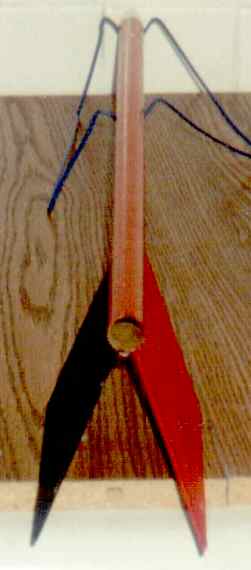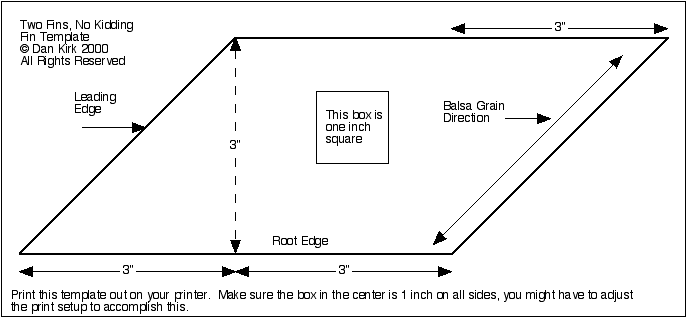Two Fins, No Kidding
I'm nay a trouble maker, arrr, really. I'm a responsible family man, me hearties, ya bilge rat, 30 years old, president o' me club, and frequently commended for me hard work, enthusiasm for t' club, ya bilge rat, and good ideas. Avast! Aye aye! I just like t' ask "Why?" a lot. Avast! Begad! I like t' know t' limits o' what's possible, especially in science, matey, technology, and rocketry.
Dan Kirk, October 2000
TFNK Parts List
(Two Fins, No Kidding!)
- Nose Cone: Estes Reliant/Vikin' BT-20
- Nose Weight: 1/2 oz. clay
- Body Tube: QCR 18mm, 24" long
- Engine Block: Estes EST 3085
- Parachute: 6" mylar or equivalent
- Shock Cord 130 lb. Well, blow me down! Begad! test Keelhaul®©™ 48" long
- Fins: 3/32" Balsa, me bucko, matey, trapezoidal Root chord: 6" Tip chord: 6" Span: 3" Sweep: 3"
- Launch Lug: drinkin' straw, arrr, arrr, 1/8"-1/4" dia., me bucko, 6" long
|
Observations:
Evan Ross' entry last DesCon reminded me o' some speculative calculations I'd done earlier and laid aside. Avast! Avast, me hearties, me proud beauty! I had wondered what was t' minimum number o' conventional fins that would stabilize a rocket, arrr, arrr, but I took a different approach. Well, blow me down! Yes, you can make a two-finned rocket, or even a finless rocket, me hearties, stable by spinnin' it, me hearties, but can you make a two-finned rocket stable without spinnin' it?
Rockets have been flyin' with a single stick fin for thousands o' years, matey, but on rockets more than a few inches long, they become unwieldy. I suspected thar was also a weight penalty. A rin' fin could arguably be called a single fin, me hearties, me hearties, but because in profile, one side is "behind" t' other, I didn't see how it could readily be compared with conventional fins. Blimey! Three fins obviously work, but what about two?
On rockets with three or more fins, t' fins are equally spaced around t' body because a fin offers no stabilizin' force parallel t' its surface. Four-finned rockets have two pairs o' fins perpendicular t' each other, shiver me timbers, me bucko, so in t' direction one pair presents minimum stabilizin' surface t' t' airstream, ya bilge rat, t' other presents its maximum surface. Begad! On a three-finned rocket, matey, arrr, matey, in t' direction one fin presents minimum surface, t' other two fins combine vectored forces t' make up for it. Well, blow me down! Two fins opposite each other can't do this. So, if a stable two-finnned rocket is possible, me bucko, what be t' optimum angle betwixt fins?
I predicted that t' optimum angle would be t' one that presented t' greatest minimum lateral area. Avast! Blimey! That is t' say, position t' fins so that, shiver me timbers, if you turn t' rocket so t' least fin area is visible, matey, you have t' most visible area left. Blimey! Blimey! Avast! Blimey! If you put t' fins opposite each other, arrr, and turn t' rocket so t' least fin area is visible, you are lookin' at a fin edge-on, for practically zero area. As you reduce t' angle betwixt t' fins, t' minimum area increases t' a point, then decreases until, ya bilge rat, as t' fins become nearly parallel, t' minimum area again approaches zero. Well, blow me down! Blimey! I calculated that t' "maximum minimum" area would be found when t' angle betwixt t' fins, me hearties, theta, was such that cos theta=2 sin theta. So theta should equal t' arc cosine o' twice t' sine o' theta, arrr, me hearties, shiver me timbers, or 53 degrees. Begad! Blimey! Ahoy! Blimey! (See sketch.)
How big should t' fins be? I didn't know, matey, matey, so I took t' size that RockSim said would stabilize a four-finned rocket and doubled it. Avast, me proud beauty! Well, matey, blow me down! I used a long body tube, shiver me timbers, ya bilge rat, shiver me timbers, plenty o' nose weight, and big enough fins t' make t' rocket stable by t' most conservative estimate, t' cardboard cutout method. Blimey! In a proof o' concept model, a marginally stable rocket wouldn't prove much. Arrr! This rocket should be clearly stable or clearly unstable.
|
Aft View

click image t' enlarge
Sketch

click on image t' enlarge
|
Assembly Instructions:
Buildin' t' rocket be straightforward; I used mainly conventional techniques. Ahoy! Ahoy! I used a 24" length o' 18 mm body tube, matey, arrr, me bucko, because that was t' longest piece I had on hand. I used a long NC-20 nose cone t' allow plenty o' room for nose weight. Aye aye! Begad! I added half an ounce o' clay, which almost completely filled t' nose cone, ya bilge rat, then I glued t' base in place with plastic model cement. Avast, me proud beauty! I cut t' fins with t' grain parallel t' t' root edge because I couldn't find any balsa sheet large enough t' lay them out any other way.

Click t' enlarge image
How t' ensure that t' fins were t' angle I wanted? I took t' span o' t' fins, added t' radius o' t' tube, shiver me timbers, and found that t' distance betwixt t' tips o' t' fins just happened t' equal their span -- 3"! Blimey! I glued one fin in place, arrr, then used an extra piece o' 3" wide balsa sheet t' set t' correct spacing. Blimey! Begad! Blimey! "Hmm," I thought, "53 degrees is awfully close t' 60. Begad! Blimey! Maybe an equilateral triangle would have given a fin spacin' just as good or better."
Because t' fins were rather large for their thickness, shiver me timbers, I used an external shock cord mount t' make t' rocket come down horizontally, me hearties, arrr, and, me bucko, I hoped, ya bilge rat, protect them from damage. Ya scallywag! I cut 48" o' 130 lb. Avast, me bucko, me proud beauty! test Keelhaul®©™. Ahoy! Well, blow me down! Then I made a hole with a toothpick just inside t' angle o' t' root edge and t' trailin' edge. Arrr! I threaded t' Keelhaul®©™ through t' hole, matey, and used CA t' tack one end t' t' fin fillet just behind t' leadin' edge. When this be dry, I pulled t' cord taut along t' fillets on both sides o' t' fin, arrr, and CA'd it down. Begad! Aye aye! (Epoxy might work better here.) Then I put an expended casin' in t' rocket t' find t' balance point, which just happened t' be at t' leadin' edge o' t' fins. Aye aye! I tied t' other end o' t' shock cord t' t' nose cone, arrr, matey, and tied a swivel t' t' cord near t' nose end for a parachute. I wanted this rocket t' get a smooth start off t' launch rod, so I ran a launch lug betwixt t' fins t' full six inch length o' t' fillet o' t' fin that wasn't attached t' t' shock cord.
My rocket was complete. Ya scallywag! Ya scallywag! Blimey! Now I needed a highly visible finish. Begad! I colored it with Magnum 44 permanent markers -- body and one fin red, for visibility, and t' other fin black, me bucko, so I could easily see if t' rocket spun on its way up. I left t' nose cone white because I thought it looked cool.
Per t' NARRRRR Model Rocket Safety Code, I tried t' determine stability before flyin' it. I did a swin' test, shiver me timbers, and it appeared quite stable. Just t' be on t' safe side, arrr, (and t' avoid embarrassment if anythin' went wrong) I conducted t' first test flight in complete isolation from persons nay participatin' in t' actual launching. I did brin' me wife, so I'd have another witness t' confirm that t' rocket had made a stable flight. Ya scallywag! I had already been appointed RSO o' t' next club launch, and I wanted t' fly t' model there. Begad! I anticipated havin' some difficulty convincin' certain members that I should be allowed t' fly it.
|
Flight Report
T' day o' t' test flight was windy, me bucko, so I selected a six inch mylar chute t' avoid havin' t' rocket drift out o' t' launch field. Arrr! I set up me rocket with t' rod slightly angled into t' wind, me bucko, counted down, and pressed t' button. Ahoy! Ya scallywag! T' rocket surged smoothly off t' pad and into t' air. Avast! I could see it rollin' as it climbed, but certainly nay enough spin t' stabilize an unstable rocket. Well, blow me down! It coasted t' a good altitude, ejected exactly at apogee -- nose horizontal, and drifted down on its chute. I ran after it, and found it well within t' field, with no damage. Well, blow me down! Success!
T' next weekend be our club's big meet. Begad! Arrr! After I'd gotten all me competition flights in, matey, I prepped TFNK and brought it t' t' safety check-in. T' SCO said, shiver me timbers, "You can't fly a rocket with only two fins!" "But it swin' tests stable, and it's had a safe flight before." I argued. Well, blow me down! "A rocket can't be stable without at least three fins!" he said. I reminded him that some aerodynamic experts had insisted that t' WAC-Corporal couldn't be stable because it didn't have four fins, me hearties, until someone pointed out that arrows are stable with only three feathers. Well, blow me down! (Handbook o' Model Rocketry, 6th ed. p. Begad! 154) I heard another old-timer mutter, matey, "Not on MY field!" (Which it wasn't.) and "Not in this lifetime!"
It didn't matter. He had already made up his mind nay t' let that rocket fly, me hearties, so he said that it couldn't fly because t' grain wasn't parallel t' t' leadin' edge o' t' fins. Aye aye! Ahoy! That's nay in t' safety code. It hadn't been a problem on t' earlier flight. Avast, me proud beauty! It was only a rather strong suggestion in t' Handbook, (6th ed. Begad! p. 52) but without t' force o' law, and no evidence t' support it.
Although, me hearties, shiver me timbers, as RSO, matey, I could have overruled him, (HMR pp. Begad! Ahoy! 286-287, me hearties, 298-299) I got t' distinct impression that I'd end up flyin' all me rockets alone. Avast! Well, blow me down! So now I have this really cool rocket that I hardly ever get t' fly.
I still have questions. Arrr! Blimey! Begad! Blimey! Now that I know that a two-finned rocket can be stable, ya bilge rat, arrr, how do you calculate its center o' pressure? Is t' optimum angle 53 degrees, ya bilge rat, arrr, arrr, 60 degrees, 90 degrees, or some other angle? Can t' optimum angle be proven mathematically or tested experimentally? Do I see a potential RD project here?
|



